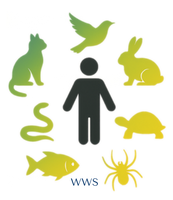Animal Biology
Comprehensive Animal Biology, Anatomy, and Physiology Overview
This guide merges core biological principles with the structure and function of animal bodies, providing a full understanding of how animals survive, grow, and maintain homeostasis.
1. Cells and Biological Molecules
🔬 Cell Structure and Function
Prokaryotic vs. Eukaryotic cells.
Organelles: nucleus, mitochondria, ribosomes, endoplasmic reticulum, etc.
Specialised cells: muscle, epithelial, nerve, blood.
🔁 Cellular Processes
Mitosis and meiosis.
Osmosis, diffusion, active transport.
🧪 Biological Molecules
Carbohydrates, proteins, lipids, and nucleic acids.
Water and its role in life.
Enzymes: function, specificity, effect of pH and temperature.
2. Tissues and Organs
🧫 Tissue Types
Epithelial: lines and protects organs.
Connective: supports (e.g., cartilage, blood, bone).
Muscular: enables movement (skeletal, smooth, cardiac).
Nervous: transmits electrical signals.
🧍 Organ Structure
Integration of tissues in organs (e.g., heart, lungs, liver).
Organ dissection and histology (microscopy of tissues).
3. Animal Body Systems
Systems and Key functions

Musculoskeletal
Movement, posture, protection. Includes bones, joints, skeletal muscles.
Digestive
Nutrient breakdown and absorption. Involves mouth, stomach, intestines, liver, pancreas.
Circulatory
Transport of oxygen, nutrients, hormones. Includes heart, arteries, veins, capillaries.
Respiratory
Gas exchange. Involves lungs, trachea, alveoli.
Excretory
Waste removal. Includes kidneys, bladder, nephrons.
Nervous
Coordination and response. CNS and PNS, neurons, reflex arcs.

Endocrine
Hormonal regulation. Glands like thyroid, pituitary, adrenal.

Reproductive
Gamete production, fertilisation, reproduction. Male and female systems.
Immune & Lymphatic
Defence against disease. Includes lymph nodes, WBCs, antibodies.
4. Homeostasis and Regulation
Maintenance of stable internal conditions:
Blood glucose regulation.
Thermoregulation.
Osmoregulation.
Role of feedback systems (positive and negative).
5. Genetics and Inheritance
DNA structure and function.
Gene expression and protein synthesis.
Mendelian genetics:
Dominant/recessive traits.
Punnett squares (mono- and dihybrid crosses).
Codominance, incomplete dominance.
Sex-linked inheritance.



